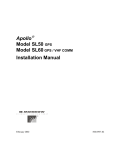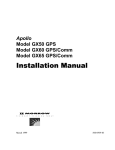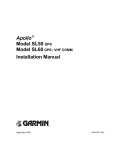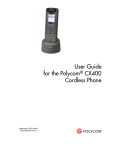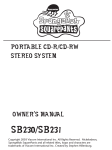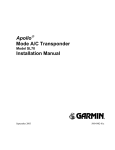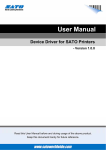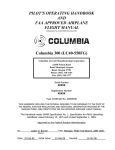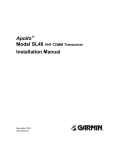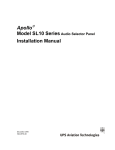Download Apollo GX55 Install Manual 560-0960-03
Transcript
Apolloâ
Model GX55 GPS
Installation Manual
July 2001
560-0960-03
ã 2001 by II Morrow Inc./UPS Aviation Technologies, Inc. All rights reserved.
Printed in the USA
No part of this document may be transmitted, reproduced, or copied in any form or by any means
without the prior written consent of II Morrow Inc. Due to II Morrow’s commitment to
constantly improve the quality and performance of our products, information contained in this
document is subject to change without notice.
UPS Aviation Technologies, II Morrow, Apollo, and Flybrary are registered trademarks of UPS
Aviation Technologies, Inc.
II Morrow Inc. (UPS Aviation Technologies, Inc.)
PO Box 13549
Salem, OR 97309
Phone (503) 581-8101
1-800-525-6726
In Canada 1-800-654-3415
FAX (503) 364-2138
www.upsat.com
2345 Turner Rd. SE
Salem, OR 97302
USA
HISTORY OF REVISIONS
Revision
--01
-02
-02a
-03
Date
6/13/97
11/17/97
3/4/99
5/9/00
7/2/01
Description
Initial release Word 6.0a document
Update for Ver 2.0 Nav software.
Update for Ver 3.0 Nav software
Add new extended data and SL30 output messages
Add autopilot roll steering data and changes for GX SW Ver 3.3
IMPORTANT NOTE
“The conditions and tests required for TSO approval of this article are minimum performance
standards. It is the responsibility of those desiring to install this article on or within a specific
type or class of aircraft to determine that the aircraft operating conditions are within TSO
standards. The article may be installed only if further evaluation by the applicant documents
an acceptable installation and is approved by the Administrator.”
Source: FAA TSO-C129
ORDERING INFORMATION
To receive additional copies of this publication, order part # 560-0960-03, Apollo GX55 GPS
Installation Manual.
REFERENCE PUBLICATIONS
Following are other publications referenced in this guide.
NOTES
Table of Contents
TABLE OF CONTENTS
SECTION 1 - INTRODUCTION ................................................................................................ 1
ABOUT THIS MANUAL...................................................................................................................... 1
APOLLO GX55 DESCRIPTION ........................................................................................................... 1
FEATURES ........................................................................................................................................ 2
SYSTEM CONFIGURATIONS ............................................................................................................... 4
VFR GPS NAVIGATION INSTALLATION......................................................................................................................4
IFR GPS NAVIGATION INSTALLATION .......................................................................................................................4
DATABASE UPDATES ........................................................................................................................ 4
REGULATORY COMPLIANCE ............................................................................................................. 5
UNPACKING THE EQUIPMENT ........................................................................................................... 5
PACKAGE CONTENTS........................................................................................................................ 5
OTHER REQUIRED MATERIALS ......................................................................................................... 5
SECTION 2 - INSTALLATION.................................................................................................. 7
PRE-INSTALLATION INFORMATION ................................................................................................... 7
INSTALLATION OVERVIEW................................................................................................................ 7
INSTALLATION CONSIDERATIONS ..................................................................................................... 7
MOUNTING CONSIDERATIONS ....................................................................................................................................7
MINIMUM SYSTEM CONFIGURATION ..........................................................................................................................7
ALTITUDE ENCODER/CONVERTER INPUT ...................................................................................................................7
EQUIPMENT MOUNTING ................................................................................................................... 8
ELECTRICAL CONNECTIONS.............................................................................................................. 9
POWER .......................................................................................................................................................................9
AVIONICS OUTPUTS ...................................................................................................................................................9
SERIAL INTERFACE .....................................................................................................................................................9
ANTENNA INSTALLATION AND CONNECTIONS ................................................................................ 10
GPS ANTENNA ........................................................................................................................................................10
POST INSTALLATION CHECKOUT .................................................................................................... 15
TEST MODE CHECKOUT AND SETUP ........................................................................................................................15
GPS NAVIGATION CHECKOUT .................................................................................................................................16
INTERFACE CHECKS .................................................................................................................................................17
FINAL SYSTEM CHECK ............................................................................................................................................19
SECTION 3 - SPECIFICATIONS ............................................................................................ 21
ELECTRICAL ................................................................................................................................... 21
PHYSICAL ....................................................................................................................................... 21
ENVIRONMENTAL ........................................................................................................................... 21
GPS RECEIVER PERFORMANCE ...................................................................................................... 22
AVIONICS OUTPUTS........................................................................................................................ 23
ALTITUDE INPUT REQUIREMENTS ................................................................................................... 23
ANNUNCIATOR REQUIREMENTS ..................................................................................................... 23
ANTENNA REQUIREMENTS ............................................................................................................. 24
GPS ANTENNA ........................................................................................................................................................24
SERIAL INTERFACE ......................................................................................................................... 24
REAR CONNECTOR PINOUT ............................................................................................................ 24
SECTION 4 - LIMITATIONS................................................................................................... 25
Apollo GX55 Installation Manual
i
Table of Contents
INSTALLATION ................................................................................................................................25
OPERATIONAL .................................................................................................................................25
APPENDIX A - TROUBLESHOOTING ..................................................................................27
CONTACTING THE FACTORY FOR ASSISTANCE ................................................................................28
APPENDIX B - PERIODIC MAINTENANCE ........................................................................29
LITHIUM BATTERY REPLACEMENT..................................................................................................29
EQUIPMENT CALIBRATION ..............................................................................................................29
CLEANING THE FRONT PANEL .........................................................................................................29
APPENDIX C - ENVIRONMENTAL QUALIFICATIONS...................................................31
APPENDIX D - ACCESSORIES ...............................................................................................33
FROM II MORROW ..........................................................................................................................33
APPENDIX E - SERIAL INTERFACE SPECIFICATIONS .................................................35
MOVING MAP OUTPUT ...................................................................................................................35
BINARY NEAREST LIST DATA (WHEN EXTENDED DATA IS ENABLED ONLY) ..................................38
ANNUNCIATOR OUTPUTS (WHEN EXTENDED DATA IS ENABLED ONLY) .........................................39
FLIGHT PLAN WAYPOINT TYPES (WHEN EXTENDED DATA IS ENABLED ONLY) ..............................40
NAVCOMM DATA OUTPUT .............................................................................................................41
REMOTE LOCALIZER LIST ........................................................................................................................................ 43
DISTANCE/SPEED/TIME MESSAGE ..................................................................................................45
ALTITUDE ENCODER/CONVERTER INPUT ........................................................................................46
FUEL / AIR DATA COMPUTER INPUT ...............................................................................................47
“S” DATA FORMAT.................................................................................................................................................. 47
“Z” DATA FORMAT ................................................................................................................................................. 49
GPSS SERIAL OUTPUT....................................................................................................................51
APPENDIX F - RETROFIT INSTALLATIONS .....................................................................53
APOLLO 602 AND 604.....................................................................................................................54
ANNUNCIATORS....................................................................................................................................................... 54
WIRING.................................................................................................................................................................... 54
ANTENNA ................................................................................................................................................................ 54
APOLLO 612 AND 618.....................................................................................................................55
ANNUNCIATORS....................................................................................................................................................... 55
WIRING.................................................................................................................................................................... 55
ANTENNA ................................................................................................................................................................ 55
APOLLO 800 FLYBUDDY .................................................................................................................56
ANNUNCIATORS....................................................................................................................................................... 56
WIRING.................................................................................................................................................................... 56
ANTENNA ................................................................................................................................................................ 56
APOLLO 819 AND 820 FLYBUDDY GPS ..........................................................................................57
ANNUNCIATORS....................................................................................................................................................... 57
WIRING.................................................................................................................................................................... 57
ANTENNA ................................................................................................................................................................ 57
ii
Apollo GX55 Installation Manual
Table of Contents
LIST OF TABLES
TABLE 1 PACKAGE CONTENTS ........................................................................................................ 6
TABLE 2 NAVIGATION INTERFACE CONNECTOR PINOUT ............................................................... 24
TABLE 3 TROUBLESHOOTING GUIDE ............................................................................................. 27
TABLE 4 RS-232 SERIAL INTERFACE SELECTIONS ........................................................................ 35
TABLE 5 MOVING MAP ASCII NAVIGATION DATA....................................................................... 36
TABLE 6 MOVING MAP BINARY ROUTE DATA .............................................................................. 37
TABLE 7 NEAREST WAYPOINT LIST DATA .................................................................................... 38
TABLE 8 ANNUNCIATOR OUTPUT DATA ........................................................................................ 39
TABLE 9 FLIGHT PLAN WAYPOINT TYPE ....................................................................................... 40
TABLE 10 ALTITUDE INPUT DATA ................................................................................................. 46
TABLE 11 FUEL/AIR DATA MESSAGE DATA (S FORMAT) ............................................................. 48
TABLE 12 FUEL/AIR DATA MESSAGE DATA (Z FORMAT) ............................................................. 50
TABLE 13 - ASCII AUTOPILOT/FUEL COMPUTER DATA ................................................................... 51
LIST OF ILLUSTRATIONS
FIGURE 1 GX55 FRONT PANEL ....................................................................................................... 2
FIGURE 2 MOUNTING FRAME ASSEMBLY ........................................................................................ 8
FIGURE 3 REAR COAX CONNECTOR ASSEMBLY ............................................................................ 11
FIGURE 4 TNC COAX CONNECTOR ASSEMBLY ............................................................................. 12
FIGURE 5 POWER AND AVIONICS CONNECTIONS ........................................................................... 13
FIGURE 6 RS-232 SERIAL CONNECTIONS ...................................................................................... 14
FIGURE 7 UNIT DIMENSIONS ......................................................................................................... 22
FIGURE 8 MOVING MAP DATA OUTPUT (EXTENDED DATA DISABLED) ........................................ 40
FIGURE 9 MOVING MAP DATA OUTPUT (EXTENDED DATA ENABLED) ......................................... 41
FIGURE 10 ALTITUDE DATA INPUT ................................................................................................ 47
FIGURE 11 FUEL / AIRDATA DATA INPUT (S FORMAT).................................................................. 49
FIGURE 12 FUEL / AIRDATA DATA INPUT ...................................................................................... 52
FIGURE 13 NYLON SPACER INSTALLATION..................................................................................... 53
Apollo GX55 Installation Manual
iii
Table of Contents
NOTES
iv
Apollo GX55 Installation Manual
Introduction
SECTION 1 - INTRODUCTION
ABOUT THIS MANUAL
This manual describes the installation of the Apollo GX55 GPS unit. It is intended for use by
persons certified by the Federal Aviation Administration (FAA) to install aircraft navigation
devices. It includes installation and checkout procedures for the GX55 unit to standards
described in FAA advisory circular AC 20-138.
Section 1
Provides an introduction to the Apollo GX55 unit. TSO certification
information is also included in this section.
Section 2
Includes installation and checkout procedures.
Section 3
Includes complete specifications.
Section 4
Includes limitations for the equipment and installation.
Appendix A
Includes troubleshooting information.
Appendix B
Includes periodic maintenance requirements.
Appendix C
Includes the environmental qualification form.
Appendix D
Includes information on accessories.
Appendix E
Includes serial data specifications.
Appendix F
Includes retrofit installation instructions.
APOLLO GX55 DESCRIPTION
The Apollo GX55 GPS is a TSO-C129, Class A2 GPS supplemental navigation receiver for
IFR en route and terminal operation. The unit features a moving map display and a database
provided by means of a plug-in data card for convenience in changing and updating the
database.
In addition to providing faster and more accurate answers to your navigation questions, the
Apollo GX55 GPS is designed to make upgrading your navigation system easier. It is a plug
compatible, slide in replacement for earlier II Morrow navigation units such as the 602, 604,
612, 618, and 800 Loran receivers and the 819 and 820 GPS receiver.
Apollo GX55 Installation Manual
1
Introduction
Figure 1 GX55 Front Panel
FEATURES
The GPS navigation features for the GX55 GPS include:
· High resolution, daylight readable graphics display
· Automatic display intensity
· Back-lit buttons
· Simple “Direct-To” navigation
· Datacard database for easy user update and replacement
· Nearest waypoint search (includes airports, VORs, NDBs, intersections, and user
waypoints)
· Remote waypoint search
· Navigation displays - Lat/Lon to 0.01 minute
- Bearing and distance to waypoint
- Ground speed and track angle
- Desired track and distance between waypoints
- Cross track error with numeric and graphic CDI
- Display of the “TO” waypoint ident
- ETE and ETA to the “TO” and destination waypoints
- Altitude (from altitude encoder/converter input)
- Minimum safe altitude and en route safe altitude information
· Map Displays
- Full screen map with bearing, distance to waypoint, and zoom level
2
Apollo GX55 Installation Manual
Introduction
·
·
·
·
·
·
·
·
·
·
·
·
·
- Split screen map with distance, speed, bearing, track, crosstrack error, To
waypoint, and zoom level
- Smart key, 1 button map declutter, Tri-state
- On map waypoint selection for information, direct-to nomination
- Track up, desired track up, and magnetic north up options
- Runway diagrams and runway names displayed
- 5nm ATC rings around airports with control towers
- Airspaces displayed by sector or outer boundary
- Airspace display controllable by type
- Approach preview page
- Route line displayed
Automatic waypoint sequencing
Built-in simulator for trip planning and training
User definable navigation pages with auto sequencing
30 flight plans of 20 legs each
500 user waypoints created by lat/lon or by radial/distance from a reference waypoint
User selectable units - nm, miles, or km for distance displays
- knots or mph for speed displays
- feet or meters for altitude displays
Real time clock (time and date) in UTC
Countdown timer
Flight timer
Automatic or manual magnetic variation
Parallel track offset
Alerts for - Loss of navigation data
- Arrival at waypoint
- Special use airspace
Full range input supply voltage
Apollo GX55 Installation Manual
3
Introduction
SYSTEM CONFIGURATIONS
The GX55 can be installed in several configurations based upon individual requirements. This
includes VFR or IFR GPS navigation. This section defines the minimum requirements.
VFR GPS NAVIGATION INSTALLATION
When installed for VFR operation, the GX55 requires only the following minimal
connections.
· an A-33 or A-34 GPS antenna
· power input
The GX55 can also be connected to other external devices such as:
· an external non-numeric indicator, such as a CDI or HSI
· external lamp annunciators including “MSG” and “PTK”
· an autopilot
· a moving map display connected to an RS-232 serial output
· an altitude encoder/converter or air data computer
· an SL40 VHF Comm radio connected to an RS-232 serial output
When the GX55 is installed for VFR, a placard stating “GPS Limited to VFR Use Only” or an
FAA approved equivalent statement must be placed next to the primary indicator
IFR GPS NAVIGATION INSTALLATION
When installed for IFR operation, the GX55 requires connections to several external
indicators. The minimum connections for IFR operation is as follows.
· an A-33 or A-34 GPS antenna
· power input
· an external non-numeric indicator, such as a CDI or HSI
· external lamp annunciators including “MSG” and “PTK”
The GX55 can also be connected to other external devices such as:
· an autopilot
· a moving map display connected to an RS-232 serial output
· an altitude encoder/converter or air data computer
· an SL40 VHF Comm radio connected to an RS-232 serial output
DATABASE UPDATES
The GX55 utilizes a Flybrary database stored on a standard plug-in memory card for easy
updating and replacement. Simply plug in the new datacard to update your existing database
or change to a new database.
Contact the II Morrow factory for information on databases available for the GX55.
4
Apollo GX55 Installation Manual
Introduction
REGULATORY COMPLIANCE
The Apollo GX55 is designed and tested to meet the following TSOs:
FAA TSO-C129 Class A2 for GPS navigation
The Apollo GX55 comply with the FCC requirements specified in:
CFR 47, Part 15, Radio Frequency Devices, Subpart B, Unintentional Radiators
Note: Operation of the GX55 connected to a PC is not currently authorized under
FCC Part 15 regulations.
The Apollo GX55 software is designed and tested to RTCA/DO-178B, level C.
Note: Un-authorized changes or modifications to the GX55 may void the
compliance to regulatory agency requirements and authorization for continued
equipment usage.
UNPACKING THE EQUIPMENT
Carefully unpack the equipment. Visually inspect the package contents for any evidence of
shipping damage. Retain all shipping containers and packaging material in case reshipment is
necessary.
PACKAGE CONTENTS
As shipped from the II Morrow factory, the Apollo GX55 package includes most items
necessary for installation (or retrofit) other than supplies normally available at the installation
shop, such as wire and cable ties, and required input and output equipment. The GX55 is
supplied in three different configurations; New installations, Loran retrofit, and Flybuddy GPS
retrofit. The standard items included in the package for each configuration are listed in Table 1.
OTHER REQUIRED MATERIALS
The GX55 is intended for use with standard aviation accessories. External devices required
for various installations are listed in the System Configurations section on page 4. Depending
upon the installation, this will include items such as:
· annunciators
· a CDI or HSI
Apollo GX55 Installation Manual
5
Introduction
Table 1 Package Contents
Part #
Units
Description
430-6050-200
Install kits
162-1008
162-1060
162-1063
162-3001
202-0001
202-0005
204-0080
221-0304
221-0400
GX55 GPS
Part number: 424-2007
Right angle coax plug
TNC coax connector
TNC to BNC right angle adapter
14-pin mini ribbon connector
Cable tie
Tie mount
Spacer, nylon, ¾ x ¾ x 0.030
3-48 x 1/4 SS pan head Phillips machine screw
4-40 x 1/4 SS pan head Phillips machine
screw with lock washer
4-40 x 3/8 SS pan head Phillips machine
screw
6-32 x 1/2 SS button head Allen screw
#3 SS internally toothed lock washer
#4 SS internally toothed lock washer
Connector cover
Shoulder bushing
Mounting frame assy,
Hex driver 3/32”
Part number: 564-0065-200
GX55 User’s Manual
GX55 Installation Manual
Binder, 5½ x 8½ x ¾, 3 ring
GX55 Quick Reference Guide
221-0406
229-0608
240-0310
240-0410
310-2030
310-2032
418-0047
998-0048
Manual kits
560-0961-xx
560-0960-01
560-9002
561-0237-xx
Accessories
560-0949-xx or
560-5047-xx
590-1104 or
590-1112
6
Qty
Loran
GPS
Retrofit Retrofit
New
Install
A-33 Installation Guide or
A-34 Installation Guide
A-33 GPS Antenna or
A-34 GPS Antenna
-200
1
1
-250
1
1
2
2
3
2
2
2
6
2
2
1
2
1
1
1
1
1
1
1
1
1
Apollo GX55 Installation Manual
Installation
SECTION 2 - INSTALLATION
This section describes the installation of the GX55 (as a new installation) including mounting,
wiring, and connections. A post installation checkout procedure is included at the end of this
section. Procedures for installing the GX55 as a retrofit for a II Morrow 602, 604, 612, 618, or
Flybuddy 800 Loran or Flybuddy 819 or 820 GPS are given in Appendix F.
PRE-INSTALLATION INFORMATION
Always follow good avionics installation practices per FAA Advisory Circulars (AC) 43.131A, 43.13-2A, and AC 20-138, or later FAA approved revisions of these documents.
Follow the installation procedure in this section as it is presented for a successful installation.
Read the entire section before beginning the procedure. Perform the post installation checkout
before closing the work area in case problems occur.
INSTALLATION OVERVIEW
A successful installation should start with careful planning including determination of
mounting location for the GX55, antenna mounting, cable routing, and other required
modifications. Once the mounting location has been determined, prepare the mounting frame
for installation. It may be easier to complete the wiring harness and attach the connectors to
the mounting frame before installing the mounting frame.
INSTALLATION CONSIDERATIONS
MOUNTING CONSIDERATIONS
The GX55 is designed to mount in the avionics stack in the aircraft instrument panel within
easy view and reach of the pilot. The standard package includes a mounting frame for ease of
mounting, connections, and service of the unit. Allow an additional one-inch clearance to the
rear of the mounting frame for connectors and cables.
For typical installations, the GX55 does not require external cooling. When mounting the unit,
ensure that a clearance of 1/8 to 1/4 inch exists between avionics units to allow for air circulation.
MINIMUM SYSTEM CONFIGURATION
The minimum system configuration and external connection requirements are described in the
section on page 4.
ALTITUDE ENCODER/CONVERTER INPUT
The GX55 includes an altitude input, which is used by the GPS RAIM calculations as well as
providing for altitude assist functions such as altitude preset and hold and 3D airspace alerts.
The GX55 altitude input can be connected from either an altitude encoder/converter or an air
data computer. The minimum requirements for the altitude input are listed in the
specifications on page 23.
Apollo GX55 Installation Manual
7
Installation
EQUIPMENT MOUNTING
Once the cable assemblies have been made, attach the 14-pin mini ribbon and coaxial cable
connectors to the rear of the mounting frame as illustrated in Figure 2. Route the wiring bundle as
appropriate. The connectors should be attached to the mounting frame before installing the frame in
the instrument panel. Connect the shield grounds directly to the rear of the mounting frame.
Once the cable assemblies are complete and the connectors are attached to the mounting
frame, install the mounting frame assembly in the instrument panel. Be sure to use low profile
head screws so the unit will slide in and out freely. Attach the front of the mounting frame to
the instrument panel. Use support brackets to attach the rear of the frame to the aircraft.
To install the GX55 slide the unit chassis into the mounting frame. Ensure that the coax
connector and the 14-pin ribbon cable connector on the back of the GX55 align with the mating
connectors in the mounting tube, then use the 3/32 hex tool to tighten (clockwise) the locking
screw. Refer also to the antenna installation information on page 10.
(2X) #3-48 x 1/4"
(2X) #3 Lock Washer
Mounting Frame Assembly
RA Coax Plug
(2X) Shoulder Bushing
(2X) #4 Lock Washer
(2X) #4-40 x 3/8" Screw
(2X) Tie Mount
(6X) #6-32 x 1/2"
Button Head Screw
(2X) Cable Tie
Connector Cover
(2X) #4-40 X 1/4" Screw
Figure 2 Mounting Frame Assembly
To remove the unit from the mounting frame, use the hex tool and turn the locking screw counterclockwise. Then pull the GX55 out of the mounting frame. No special extraction tools are required.
8
Apollo GX55 Installation Manual
Installation
ELECTRICAL CONNECTIONS
Wiring necessary for installation of the GX55 includes the rear panel electrical connections
and the antenna cable placement. The 14 pin mini ribbon connector and coax connector must
be assembled to the frame and may be wired before or after being installed in the mounting
frame. The recommended connecting wire size for the 14-pin connector is 20 to 24 AWG.
Wiring diagrams are included in Figure 5 (power and avionics) and Figure 6 (serial interface).
POWER
The GX55 power input is internally fused at 3 amps. A separate 2 amp (maximum) circuit
breaker or fuse should be installed for downline overload or short circuit protection. Make the
power connections to the unit using 20 AWG wire.
Note: Circuits should be protected in accordance with guidelines in AC 43.13-1A,
chapter 11, section 2, paragraph 429.
AVIONICS OUTPUTS
The GX55 includes avionics outputs for CDI/HSI indicators, autopilot, and annunciators.
These outputs are to be connected as appropriate for the particular installation. The CDI/HSI
outputs may be connected to a dedicated CDI or HSI or to a shared indicator using an
appropriate switching relay. The avionics outputs available are listed in the Avionics Outputs
specification on page 23. Connect the annunciator outputs to lamp indicators as described in
the specifications. The minimum connections required for different installations are listed in
the System Configurations on page 4.
If a switching relay is used to make connections to a shared CDI/HSI, it should be a minimum
of an eight pole relay box with an appropriate selector switch with annunciation. Since the
GX55 is not approved for approach operation, the ILS enable signal (see Figure 5) from a
connected ILS receiver can be connected to automatically switch the indicators back to the
nav receiver when an ILS frequency is selected.
SERIAL INTERFACE
The GX55 includes an RS-232 serial port for making optional connections. The serial port can
be used for connecting to such devices as the Apollo SL40 comm, a moving map display,
multi-function display, autopilot, VHF Nav/Com, Fuel Air/Data computer, or an altitude
encoder/converter. Serial output connections should be limited to no more than three external
units.
When making connections to the GX55, use a three conductor shielded cable. Make RxD,
TxD, and signal ground connections to the 14-pin connector. Connect the shield(s) to the rear
of the mounting frame. The shield leads must be < 1.25 inches. See Figure 6.
Complete serial interface specifications are included in Appendix E.
Apollo GX55 Installation Manual
9
Installation
ANTENNA INSTALLATION AND CONNECTIONS
GPS ANTENNA
The mounting location and cable connections for the GPS antenna are very important. The
antenna should be mounted no closer than two feet from VHF comm transmitter antennas, six
inches from other antennas emitting less than 25 watts, and two feet from higher power
antennas. Special care should be taken to ensure that the GPS antenna is not mounted in close
proximity to antennas that may emit harmonic interference at the L1 frequency of 1575.42
MHz. Refer to the antenna installation manual for installation instructions.
The connectors are included in the installation kit, and are intended for use with RG-142B size
coax cable. If using a different diameter coax, alternative connectors may be required. Assembly
instructions for the connectors are included in Figure 3 and Figure 4. RG-142B cable can be used
as long as the length is less than 20 feet. For longer lengths, use a low loss 50W coax.
Suggestion: Temporarily locate the GPS antenna with coax connected to the GX55 and check
the GPS performance as described in the GPS Operation and Position test in the Post
Installation Checkout on page 17. Once a suitable location has been verified, then
permanently mount the antenna.
Note: If using a GPS antenna that was already on the aircraft, or if mounting the antenna
closer than two feet from a comm antenna, conduct the GPS Operation and Position test in
the Post Installation Checkout on page 17. If the GX55 passes the test, then moving the
antenna is not necessary.
Once the antenna mounting position has been prepared, route the coax cable from the antenna
to the GX55. Proper selection of coax cable and assembly of connectors is critical to GPS
signal performance. The cable loss from the antenna to the GX55 should be limited to a
maximum of 4 dB. Minimize the coax length for optimum performance and DO NOT coil
excess cable. Leave only enough for service loops. The coaxial connectors and adapters, such
as TNC to BNC, add additional loss to the cable and should be considered when computing
the maximum 4 dB loss. A typical loss of 0.2dB can be used for each connection. The typical
cable loss for 20 feet of RG-142B coax with a connector on each end is 4 dB.
During the post-installation checkout, susceptibility to harmonics of VHF comm transmitters
will be evaluated. If problems arise, then better isolation, or distance, may be required
between the GPS and comm antennas, or a notch filter may be installed in series with the
antenna coax of the VHF comm transceiver to reduce or eliminate the harmonic interference.
A notch filter for this use (part #162-1059) is available from II Morrow.
If a VHF comm transmitter causes problems with the GPS on the selected frequencies as
listed in the post-installation checkout, the problem may be due to the ELT. This can be
verified by disconnecting the ELT antenna coax at the ELT unit. If the ELT is found to cause
the problem, then contact the ELT manufacturer or replace the ELT.
10
Apollo GX55 Installation Manual
Installation
Figure 3 Rear Coax Connector Assembly
Apollo GX55 Installation Manual
11
Installation
Figure 4 TNC Coax Connector Assembly
12
Apollo GX55 Installation Manual
Installation
Figure 5 Power and Avionics Connections
Apollo GX55 Installation Manual
13
Installation
Figure 6 RS-232 Serial Connections
14
Apollo GX55 Installation Manual
Installation
POST INSTALLATION CHECKOUT
Once the unit is installed, complete the checkout procedure to verify proper operation. Refer
to the User’s Guide for operating instructions.
The steps that are not applicable to a particular installation may be skipped. A checkout log
sheet is included on page Error! Bookmark not defined. to fill out during the checkout
procedure. Make a photocopy of the log sheet for ease of use if desired.
The checkout procedure is broken into several groups. The GPS Navigation Checkout and the
Final System Check should be completed with the aircraft moved clear of hangers and other
structures.
Mounting / Wiring Check
Verify that all cables are properly secured and shields are connected to the rear of the
mounting frame. Check the movement of the aircraft controls to verify that there is no
interference.
TEST MODE CHECKOUT AND SETUP
The GX55 has a built-in test mode to simplify the checkout. To operate the GX55 in the test
mode, hold down the leftmost and rightmost “smart keys” while switching on the power. To
return to normal operation, switch the power off, then back on.
Avionics Outputs
Check the avionics output connections by using the test mode as follows. Rotate the LARGE
knob to select each test.
1. Using the “CDI TRIANGLE” page, rotate the SMALL knob to check left, mid, and right.
2. Using the “TO/FROM FLAG” page, rotate the SMALL knob to check the Off, To, and From
outputs.
3. Using the “LAMP OUTPUTS” page, rotate the SMALL knob to check all the connected
annunciators.
4. Using the “VALID FLAG PAGES” page, rotate the SMALL knob to check all the connected
valid flag outputs.
Installation Configuration
The GX55 must be configured to match the operation supported by the installation. This
includes IFR, VFR, and SAR operation selections.
1. In test mode, rotate the LARGE knob to the “OPTIONS:” page.
2. Press SEL, rotate the SMALL knob to select VFR (IFR? NO), IFR (IFR? YES), SAR
(SAR? YES) (Search and Rescue) operation, then press ENT when complete.
Note: Make sure that all installation requirements are complete for the selected operation.
Refer the System Configurations section on page 4 for installation requirements.
Serial Interface Configuration
The GX55 RS-232 serial port can be configured for several different input and output formats.
To select the serial port configurations:
1. In test mode, rotate the LARGE knob to the serial port configuration “CH RX TX” page.
2. Press SEL (the selection field will start flashing), rotate the SMALL knob to make the
desired selection, then press ENT when complete.
Apollo GX55 Installation Manual
15
Installation
The available serial port configurations are included in Appendix E. An example of typical
settings is shown below.
CH
Rx
Tx
1:
NAV
MapCom
Other Test Mode Pages
The GX55 test mode includes several other pages that are not necessary for the checkout.
They are as follows:
“TO TEST DISPLAY” ...................... Can be used to check the GX55 front panel displays by
pressing ENTER.
“TEST CONTROLS”......................... Can be used to check the GX55 front panel controls. Press
each button and rotate the SMALL knob to check the
controls.
“OPERATION STATUS:” ................. Factory use only. Should be set to “STANDARD.”
“SYSTEM INITIALIZATION”............. Factory use only. Used to reset all internal memory
including user waypoints, flight plans, and configuration
data.
Caution: Using the system initialization
function will cause all user data to be lost!
“SERIAL PORT TEST” ..................... Factory use only. Used to check the RS-232 serial port.
"Extended MovMap
Data Format" ................................ Enable/Disable extended moving map data. This should
be enabled when interfaced with an Apollo MX20 or
Sandel HSI. Call Customer Service if you have questions.
“A/D CHANNEL 1:” ....................... Factory use only. Used to check internal circuits and
display voltages.
“EEPROM BYTE 0000:”............... Factory use only. Used to display eeprom setup memory.
GPS NAVIGATION CHECKOUT
Switch on the GX55 in the normal mode to complete this part of the checkout. The GX55 will
go through a sequence of self-tests.
The GX55 requires a “seed” position, time, and date for the GPS sensor to know which
satellites to look for. Once this is entered, it will be saved and updated automatically. If the
GX55 is moved a great distance without being turned on, the seed position may have to be reentered.
Entering the seed position:
1. During the display startup sequence, press SEL when the position page is displayed.
2. Rotate the LARGE knob to move the cursor to different fields, rotate the SMALL knob to
input the correct lat/lon, and then press ENT to save the changes.
The seed position can also be input with reference to a waypoint. Refer to the user’s manual
for instructions.
16
Apollo GX55 Installation Manual
Installation
Entering the time and date:
1. Press the SYS button, rotate the LARGE knob to display the “SYSTEM INFO” page, and
press ENTER.
2. Press SEL, rotate the LARGE knob to move the cursor to different fields, rotate the SMALL
knob to input the correct time, and then press ENT to save the changes.
GPS Operation and Position
This checkout is to be completed with the aircraft moved away from hangars and other
structures that may obstruct the view of the satellites.
1.
2.
3.
4.
5.
Turn on the GX55 and allow the unit to acquire a position. All other avionics should be
turned off for this part of the test.
Check the position using the lat/lon navigation page. Press the NAV button and rotate the
LARGE knob to the lat/lon page. The lat/lon should agree with a known reference
position.
Check the signal reception using the GPS sensor displays in the System mode. Press the
SYS button, rotate the LARGE knob to the “GPS SENSOR:” page, and press ENT. Then
rotate the SMALL knob to display the GPS info. Typical signal levels are 50 or better.
Turn on other avionics one at a time and check the GPS signal reception to make sure it
is not affected.
Check for VHF comm transmitter interference. This must be completed on all IFR
installations.
a) Verify that 5 to 8 satellites are in DATA and the NAV flag is out of view.
b) Tune the comm to 121.150 MHz and transmit for 20 seconds.
c) Verify that the position is not lost.
d) Repeat for additional frequencies as follows.
121.125 MHz
131.225 MHz
121.175 MHz
131.250 MHz
121.200 MHz
131.275 MHz
121.225 MHz
131.300 MHz
121.250 MHz
131.325 MHz
131.200 MHz
131.350 MHz
e) Repeat for each comm transmitter.
f) If the GX55 is susceptible to VHF comm transmitter interference, then better
isolation, or distance, may be required between the GPS and VHF antennas. With
some comm transmitters, a notch filter may be required in series with the VHF
comm antenna coax at the rear of the comm unit.
Note: Older VHF comm transmitters may emit higher levels of harmonic interference
causing greater problems and may be more difficult to deal with.
INTERFACE CHECKS
The interfaces to other equipment, such as the SL40 or a moving map display, should be
checked. Make sure the other equipment is connected and switched on. The Apollo GX must
have a seed position and be navigating to a waypoint to check the interfaces.
Apollo GX55 Installation Manual
17
Installation
To check the serial data output connections, verify the data from the GX55 can be displayed
on the other units, such as a moving map display or the SL40.
Apollo SL30
When your Apollo GX is connected to and configured to communicate with an Apollo SL30
Nav/Comm, your Apollo GX will exchange information with the SL30. If the following steps
do not perform correctly, check the electrical connections and configuration setup.
1. In the Apollo GX, view Tuned Station page in Nav mode. The tuned station identifier and
frequency sent by the Apollo SL30 should be displayed.
2. In the Apollo SL30, Distance, Speed, and Time information for the selected station should
be displayed. The Distance, Speed, and Time information for the selected station shown in
the SL30 ensures that the GX and SL30 are communicating.
If your Apollo SL30 is only configured to receive, use the following steps for checkout.
1. In the SL30, press NAV.
2. Then, press SEL.
3. Note the you should see the three to four letter designator for either the Localizer for the
destination or the closest VOR to your current position.
Apollo SL40
The Remote function will allow the SL40 to access the airport frequency database in an
Apollo GPS receiver. If the following steps do not perform correctly, check the electrical
connections and configuration setup.
1. In the SL40, press RCL to view the Remote (REM) frequencies.
2. Then, turn the SMALL, inner knob to display the available frequencies. The waypoint type
and frequency are displayed.
Apollo MX20
The Apollo MX20 must be installed and setup according to its installation manual. If the
following steps do not perform correctly, check the electrical connections and configuration
setup.
1. Check the System Info page on the MX20 to verify that the data is available to each port
and that it is being processed properly.
2. The GX55 Flight plan will be displayed on the MX20 on the FPL page.
Altitude Encoder and Fuel Air/Data Computer
In the System Mode check the Misc Sensors function. If the following steps do not show the
correct information, check the electrical connections and configuration setup.
1.
2.
3.
4.
18
Press SYS. Turn the LARGE knob to Misc Sensors and press ENTER.
The Encoding Altimeter value will be displayed.
Turn the LARGE knob to view Air Data Info.
Turn the LARGE knob to view Fuel Info.
Apollo GX55 Installation Manual
Installation
FINAL SYSTEM CHECK
The GX55 GPS navigation functions should be complete at this time. The final check includes
checking database, entering a direct to waypoint, and checking the navigation functions. Start
with the unit turned on and operating in the normal mode. Refer to the user’s manual for
operating instructions.
1. Verify a valid position is displayed.
2. Check the database to ensure it is for the right coverage area and is not expired. To
check the database:
a) Press SYS, rotate the LARGE knob to the “SYSTEM INFO” page, and press ENT.
b) Rotate the LARGE knob to the Apollo GX “SOFTWARE VERSION” page
c) Rotate the SMALL knob to display the database information. The database name,
expiration date, and version will be displayed.
3. Enter a direct to waypoint. Press the DIRECT-TO button, use the LARGE and SMALL knobs
to select a nearby waypoint, then press ENT. Or use the nearest search function to select
a waypoint.
4. Verify the bearing and distance to the selected waypoint.
If the database is expired, or if a different coverage area is needed, contact the II Morrow
factory for an update.
Apollo GX55 Installation Manual
19
Installation
APOLLO GX55 POST-INSTALLATION CHECKOUT LOG
CONFIGURATION INFORMATION:
o GX55 GPS
430-6050-2__ Mod ____
TEST MODE CHECKOUT AND SETUP:
Avionics Outputs:
o [o N/A] CDI (left, mid, right)
o [o N/A] TO/FROM flag (OFF, TO,
FROM)
o [o N/A] External annunciators
o [o N/A] Valid flag
GPS NAVIGATION CHECKOUT:
o Seed position entered
o Time, date entered
GPS Operation:
o Position check
o Signal reception check
o Interference from other avionics checked
o VHF Comm interference check
Date: ___/___/___
By: _____________
Serial # ___________
GPS Antenna: ___________
Installation Configuration:
IFR?: o Yes o No
SAR?: o Yes o No
Serial Interface Configuration:
_________________________
Interface Checks:
o [o N/A] RS-232 output checked
o [o N/A] Map/Mapcom
o [o N/A] RS-232 input checked
o [o N/A] Altitude Encoder
o [o N/A] NAV
o [o N/A] F/ADC
FINAL SYSTEM CHECK:
o Database checked
o Navigation data checked
o Direct To waypoint entered
o DST data acceptable*
* Note: Distance, Time, and speed information sent through the serial port must be displayed in
an acceptable manner. See Limitations in Sec. 4.
COMMENTS:
20
Apollo GX55 Installation Manual
Specifications
SECTION 3 - SPECIFICATIONS
This section includes detailed electrical, physical, environmental, and performance
specifications for the Apollo GX55.
ELECTRICAL
Input voltage............................................. 10VDC to 40VDC, reverse polarity protected
Input current (GPS navigation input) ....... 500 mA typical, 750 mA max. at 13.75VDC
250 mA typical, 375 mA max. at 27.5VDC
Input power (GPS navigation input)......... 7 watts typical
Internal fuses ............................................ 3 amp fast blow, surface mount on board.
The fuse must be replaced with the same or
equivalent type (contact the factory).
Memory backup........................................ Internal lithium battery with a service life of
approximately 4 to 6 years. See Appendix B for
battery replacement instructions.
Note: The GX55 will provide a message on the display when the lithium battery is
running low and needs replacement.
PHYSICAL
Height ....................................................... 2.00 inches (5.08 cm)
Width........................................................ 6.25 inches (15.88 cm)
Depth ........................................................ 11.125 inches (28.26 cm) behind panel, including
mounting frame and connectors
Weight (with mounting frame)................. 2.6 lb. (1.179 kg)
ENVIRONMENTAL
The Apollo GX55 units are designed and tested to meet appropriate categories of RTCA/DO160C. The Environmental Qualification Form is included in Appendix C.
Operating temperature .............................. -20°C to +55°C
Storage temperature.................................. -55°C to +85°C
Temperature variation .............................. 2°C per minute
Humidity................................................... 95% at 50°C for 6 hours (2 day cycle)
Maximum altitude .................................... 55,000 feet
Cooling ..................................................... Not required
Apollo GX55 Installation Manual
21
Specifications
Figure 7 Unit Dimensions
GPS RECEIVER PERFORMANCE
Number of channels ..................................8
Frequency..................................................1575.42 MHz L1, C/A code
Sensitivity (acquisition) ............................-135 dBm
Sensitivity (drop lock)...............................-142 dBm
Dynamic range ..........................................> 20 dB
Lat/Lon position accuracy.........................15 meters RMS typical
25 meters, SEP, without SA
100 meters 2DRMS with SA
Velocity.....................................................1000 knots maximum
Acceleration ..............................................4G maximum
TTFF (time to first fix) .............................25 seconds typical with current almanac, position,
time, and ephemeris
55 seconds typical with current almanac, position,
and time
Reacquisition.............................................2.5 seconds typical
Position update interval.............................1 second typical
Datum........................................................WGS-84
22
Apollo GX55 Installation Manual
Specifications
AVIONICS OUTPUTS
CDI L/R deviation .................................... ±150 mv full scale, will drive up to 200 ohm load
TO/OFF/FROM flag................................. ±250 mv, TO/FROM indication, will drive up to
200 ohm load
Nav valid flag ........................................... +300 mv for valid indication, will drive up to 100
ohm load
Annunciators ............................................ Open collector outputs capable of sinking up to
400 mA for turning ON annunciator lamps
·
·
MSG (message) ON indicates message(s) active
PTK (parallel track) ON indicates parallel track
is enabled
ALTITUDE INPUT REQUIREMENTS
The altitude data can be input to the GX55 from either an altitude encoder or serializer, or
from an air data computer.
The minimum requirements of the optional altitude data input are as follows:
Input method............................................. RS-232
Type.......................................................... pressure altitude
Resolution................................................. 100 feet minimum
Accuracy................................................... must meet accuracy requirements of TSO-C88a
Note: Installation of altitude input equipment, such as encoders, must be done according to
their installation instructions.
Note: Specifications for the RS-232 altitude input are included on page 39.
ANNUNCIATOR REQUIREMENTS
The GX55 installed for IFR operation require the following annunciators. Each annunciator
should include a lamp of the proper voltage for the installation.
Legend
Color
MSG
amber
PTK
blue or white
The annunciators should be connected to a suitable dimming circuit for night time operation.
amber
MSG
PTK
blue
Example Annunciators
Apollo GX55 Installation Manual
23
Specifications
ANTENNA REQUIREMENTS
GPS ANTENNA
The GX55 is designed to operate properly with the A-33 or A-34 GPS antennas. The GX55
supplies 5 volts for the antenna.
SERIAL INTERFACE
RS-232 ......................................................Defined in Appendix E - Serial Interface
Specifications
REAR CONNECTOR PINOUT
The GX55 includes a 14-pin rear panel connector for the GPS navigation connections. The
pinout for the connector is listed in the following table.
Table 2 Navigation Interface Connector Pinout
Pin #
I/O
1
2
3
4
5
6
7
8
9
10
11
12
13
14
O
O
O
O
O
O
I
O
O
O
O
I
-I
Connection
Function
PTK
+ TO
Message
CDI + Right
CDI + Left
TxD
RxD
Serial ground
+ FROM
valid flag ground
Nav + valid
Power ground
reserved
Power +
Parallel track annunciator output
+ To flag output
Message annunciator output
CDI + Right output
CDI + Left output
RS-232 serial data output
RS-232 serial data input
RS-232 signal ground
+ From flag output
signal ground connection
Nav low level valid flag output
main power ground input
do not connect
main DC power input
1
3
5
7
8
10
12
14
View from rear of mounting frame
24
7
1
14
8
View from inside frame
Apollo GX55 Installation Manual
Limitations
SECTION 4 - LIMITATIONS
INSTALLATION
For minimum equipment and connections required for VFR or IFR installations, refer to the
System Configurations on page 4.
Installations of the GX55 GPS navigation functions are to be made in accordance with AC 20138, or other appropriate FAA approved guidelines.
When the GX55 is installed for VFR, a placard stating “GPS Limited to VFR Use Only” or an
FAA approved equivalent statement must be placed next to the primary indicator.
When Nav tuning is provided to the GX, the GX will output Distance, Speed, and Time
(DST) information on the MapCom output. It is the installers responsibility to ensure that this
information is displayed in an acceptable fashion. For instance, in an installation where two
Apollo SL30’s are integrated in the system, it is not appropriate to display DST information
on the SL30 that is not providing the tuning information. Apollo SL30 SW version 1.2, or
later, provides the means for disabling the display of DST information.
OPERATIONAL
An approved Aircraft Flight Manual Supplement is required for IFR installations.
Note: A sample AFM supplement is available from II Morrow listing operational limitations.
Apollo GX55 Installation Manual
25
Limitations
NOTES
26
Apollo GX55 Installation Manual
Troubleshooting
APPENDIX A - TROUBLESHOOTING
This appendix provides information to assist troubleshooting if problems occur after
completing the installation. Use Table 3 to assist in troubleshooting.
Table 3 Troubleshooting Guide
Problem
Cause
The GX55 does not power on.
The unit is not getting power.
The GX55 does not compute a
position.
The GPS signal levels are very
low.
GPS signal levels drop when
avionics are turned on.
Display flashes from power
interrupts
Solution
Check power connections, breakers,
and main avionics switch.
Not receiving signals, or incorrect
Make sure a correct position and
seed position, time, and date.
time/date have been entered. Check
the GPS antenna connections. Make
sure the aircraft is clear of hangers,
buildings, trees, etc.
Improper antenna installation or coax Check GPS antenna installation,
routing.
connections, and cable routing. The
GPS antenna must be mounted on the
top of the aircraft.
Antenna shaded from satellites.
Make sure the aircraft is clear of
hangers, buildings, trees, etc.
RF interference at 1575.42MHz from Move GPS antenna further from the
VHF comm.
comm antenna. Add a 1575.42 MHz
notch filter in comm coax. Fix or
replace the comm. Disconnect the
ELT antenna coax.
Noise interference from other
Turn all avionics off, then turn on
avionics.
each piece one at a time to isolate the
source of the interference. Route
cable and antenna away from sources
of interference.
Caused by momentary power
This is normal operation of the GX55,
interruptions in the electrical system, operation recovers in approximately 1
typically due to changing power
second. If it becomes a problem,
sources.
check the electrical system.
Apollo GX55 Installation Manual
27
Troubleshooting
CONTACTING THE FACTORY FOR ASSISTANCE
If the Apollo GX55 unit fails to operate despite troubleshooting efforts, contact the II Morrow
factory for assistance.
II Morrow Inc.
2345 Turner Rd. SE
Salem, Oregon 97302
USA
Phone (503) 581-8101 or 1-800-525-6726
Be prepared with the following information about the installation:
· Installation configuration (accessories, antenna, ...)
· Model number, part number with mod levels, and serial number
· Software versions
· Description of problem
· Efforts made to isolate the problem
· other installed avionics
28
Apollo GX55 Installation Manual
Periodic Maintenance
APPENDIX B - PERIODIC MAINTENANCE
The GX55 unit is designed to not require any regular general maintenance except as included
in this section.
LITHIUM BATTERY REPLACEMENT
The internal keep-alive battery will require replacement after 4 to 6 years. Regular planned
replacement is not necessary. The GX55 will display a “low battery” message when
replacement is required. Once the low battery message is displayed, the battery should be
replaced within 1 to 2 months. If the battery is not replaced, the internal ram memory and the
system clock information will be lost.
To replace the battery, remove the GX55 from the aircraft, remove the top cover, and replace
the battery. Make sure to insert the battery in the correct polarity. Replace the top cover, reinstall the unit in the aircraft, and verify unit operation.
Battery replacement should be done only by the II Morrow factory or by a trained technician.
Note: The battery is to be replaced only with II Morrow part #148-1702, or a
II Morrow approved equivalent.
Caution
The battery may explode if mistreated. Risk of fire, explosion, and burns. Do
not recharge, disassemble, heat above 100°C, or incinerate.
Dispose of batteries promptly. Keep away from children.
Be sure the battery is inserted in the right direction.
EQUIPMENT CALIBRATION
The GX55 design requires very few adjustments or calibration to be made. In fact, there are
no internal manual adjustments.
CLEANING THE FRONT PANEL
The front bezel, keypad, and display can be cleaned with a soft cotton cloth dampened with
clean water. DO NOT use any chemical cleaning agents. Care should be taken to avoid
scratching the surface of the display.
Apollo GX55 Installation Manual
29
Periodic Maintenance
NOTES
30
Apollo GX55 Installation Manual
Environmental Qualifications
APPENDIX C - ENVIRONMENTAL QUALIFICATIONS
The Apollo GX55 has been tested to the following environmental categories per procedures
defined in RTCA/DO-160C.
Model:
Part No:
TSO No:
Environmental Qualification Form
Manufacturer:
II Morrow Inc.
2345 Turner Road SE
Salem, Oregon 97302
Section Description of Conducted Tests
GX55
430-6050-2xx
TSO-C129 Class A2
Conditions
Temperature and Altitude
In-flight Loss of Cooling
Altitude
Decompression
Overpressure
Temperature Variation
Humidity
Vibration
8.0
Explosion Proofness
Waterproofness
Fluids Susceptibility
Sand and Dust
Fungus Resistance
Salt Spray
Magnetic Effect
Power Input
Voltage Spike
Audio Frequency Conducted
Susceptibility - Power Inputs
Induced Signal Susceptibility
Radio Frequency Susceptibility
(Radiated and Conducted)
Emission of Radio Frequency
Energy
Lightning Induced Transient
Susceptibility
9.0
10.0
11.0
12.0
13.0
14.0
15.0
16.0
17.0
18.0
Equipment tested to Category F1 with
No cooling required
Equipment tested to 55,000 feet
Equipment tested to 8K to 55K in < 15 seconds
Equipment tested for overpressure
Equipment tested to Category C, 2°C/min
Equipment tested to Category A, standard humidity
environment
Equipment tested for both operational and crash safety
shocks. (Equipment operated normally after the crash safety
shocks.)
Equipment tested without shock mounts to Categories B, M,
&N
Equipment identified as Category X, no test required
Equipment identified as Category X, no test required
Equipment identified as Category X, no test required
Equipment identified as Category X, no test required
Equipment identified as Category X, no test required
Equipment identified as Category X, no test required
Equipment is Class Z
Equipment tested to Categories A & B
Equipment tested to Category A
Equipment tested to Categories A & B
19.0
20
Equipment tested to Category Z
Equipment tested to Category U
21
Equipment tested to Category Z
Operational Shocks and Crash
Safety
4.0
4.5.4
4.6.1
4.6.2
4.6.3
5.0
6.0
7
22.0
Equipment tested to Category A3 for the GPS navigation connections
Category A1 for the GPS antenna connector
Equipment identified as Category X, no test required
Equipment identified as Category X, no test required
Lightning Direct Effects
23.0
Icing
24.0
Remarks:
Also tested to meet IEC 801-2 / 1984 & 1991 ESD requirements and EN55022 Class B emissions.
Apollo GX55 Installation Manual
31
Environmental Qualifications
NOTES
32
Apollo GX55 Installation Manual
Accessories
APPENDIX D - ACCESSORIES
This appendix includes information on accessory items available for the Apollo GX55. Refer
to the information that is provided with those items for complete specifications and
installation instructions.
FROM II MORROW
A-33 Antenna
II Morrow Part #:...................................... 590-1104
Manufacturer: ........................................... Aero Antenna
Manufacturer #: ........................................ AT-575-9
The A-33 GPS antenna is a standard accessory item with the GX55. The A-33 includes a
built-in preamp with 26 dB gain and has a low profile, low drag radome mounted on a die cast
aluminum base. It has a maximum altitude of 55,000 feet and weighs only 3.9 ozs. See the
installation manual for the A-33 for complete specifications and installation instructions.
A-34 Antenna
II Morrow Part #:...................................... 590-1112
Manufacturer: ........................................... Aero Antenna
Manufacturer #: ........................................ AT-575-93
The A-34 GPS antenna is a standard accessory item with the GX55. The A-34 includes a
built-in preamp and has a low profile, low drag radome mounted on a die cast aluminum base.
It has a maximum altitude of 55,000 feet and weighs only 7.0 ozs. See the installation manual
for the A-34 for complete specifications and installation instructions. The A-34 mounts in the
same footprint as the II Morrow A-16 and A-23 Loran antennas to simplify upgrading.
Apollo GX55 Installation Manual
33
Accessories
GX55 Power Cable Assy
II Morrow Part #: ......................................500-4027-00
Manufacturer:............................................II Morrow Inc.
The GX55 Power Cable Assy is an optional accessory item used to provide a power input to
the GX55 from a DC power supply.
34
Apollo GX55 Installation Manual
Serial Interface Specifications
APPENDIX E - SERIAL INTERFACE SPECIFICATIONS
This appendix includes the RS-232 serial port interface specifications.
The RS-232 serial interface configurations supported by the GX55 are listed in Table 4.
Instructions for configuring the serial port are included in the checkout procedure on page 15.
Serial output connections should be limited to no more than three external units.
Table 4 RS-232 Serial Interface Selections
RX
NONE
NONE
TX
NONE
MOVMAP
NONE
NAV
MAPCOM
MAPCOM
ALTENC
ALTENC
NONE
MOVMAP
ALTENC
MAPCOM
KEYPAD
KEYPAD
KEYPAD
NONE
MOVMAP
MAPCOM
FADC
PC
MOVMAP
SETUP
Comment
No input or output
Moving map data output. Tested units include the
following: EI FP5, JPI, Sandel 3308, Argus 3000, 5000,
7000 and Shadin Digiflow, Miniflow, Microflow. The
installer must verify other devices.
Moving map data output with SL40 comm data
Nav info input of frequency, identifier, and OBS resolver
value from Apollo SL30. Moving map data output with
SL40 comm data.
Altitude encoder-converter data input, no output
Altitude encoder-converter data input, moving map data
output
Altitude encoder-converter data input, moving map data
output with SL40 comm data
Keypad data input
Keypad data input, moving map data output
Keypad data input, moving map data output with SL40
comm data
Fuel / Airdata input, moving map data output.
Used for factory test
MOVING MAP OUTPUT
The format of the moving map data output is as follows. Definitions of the output data is
included in Table 5 and Table 6. A sample output message is included in Figure 8.
Baud rate: ......................................... 9600
Data bits: .......................................... 8
Stop bits: .......................................... 1
Parity: ............................................... none
Output rate: ....................................... approx. 1 seconds
Message length: ................................ variable, approx. 83 to 750 characters
The serial output messages are in the following format.
<STX><id><data><it><id><data><it>...<id><data><it><ETX>
<STX> .............................................. ASCII “start of text” character (1 byte, 02h)
Apollo GX55 Installation Manual
35
Serial Interface Specifications
<id> ...................................................item designator (1 byte, from following table)
<data> ...............................................item data (format listed in following table)
<it> ....................................................item terminator (1 byte, 0Dh)
<ETX> ..............................................ASCII “end of text” character (1 byte, 03h)
Table 5 Moving Map ASCII Navigation Data
36
ID
A
Data Format
sddmmhh
Length
9
B
sdddmmhh
10
C
D
E
G
ddd
ddd
ddddd
sdddd
3
3
5
5
I
dddd
4
K
ddd[dd]
L
dddd
4
Q
sddd
4
T
---A-----
9
3 to 5
Description
Present latitude
s =sign: N for north, S for south
dd = degrees
mm = minutes
hh = hundredths of minutes
Present longitude
s = sign: E for east, W for west
ddd = degrees
mm = minutes
hh = hundredths of minutes
Track (magnetic): ddd = degrees
Ground speed: ddd = knots
Distance to active waypoint: ddddd = nm x 10
Cross track error:
s = sign: R for right, L for left of course
dddd = distance off course, hundredths of nm
Desired track (magnetic):
dddd = degrees x 10
Active waypoint identifier:
ddd[dd] = ASCII waypoint identifier
Bearing to active waypoint (magnetic):
dddd = degrees x 10
Magnetic variation:
s = sign: E for east, W for west
ddd = degrees x 10
Warnings: The 4th character will be an “A”
when the navigation data is flagged, otherwise,
all characters will be dashed. All other
navigation data will be dashed when it is
flagged.
Apollo GX55 Installation Manual
Serial Interface Specifications
Table 6 Moving Map Binary Route Data
Byte
1
2-3
4
Data Format
w
dd
xiannnnn
5-9
10
11
12
ddddd
sddddddd
xxmmmmmm
xhhhhhhh
13
14
15
16
sxxxxxxx
dddddddd
xxmmmmmm
xhhhhhhh
17
18
nnnnnnnn
nnnnnnnn
19
<CR>
Apollo GX55 Installation Manual
Description
Item designator
Current waypoint number in ASCII (01h to 20h)
Sequence number
x = undefined
i = 1 if last waypoint
a = 1 if active waypoint
nnnnn = unsigned binary waypoint number
ASCII waypoint identifier
Waypoint latitude - packed, unsigned binary
s = sign: 0 for north, 1 for south
ddddddd = degrees
mmmmmm = minutes
hhhhhhh = hundredths of minutes
x = undefined
Waypoint longitude
s = sign: 0 for east, 1 for west
dddddddd = degrees
mmmmmm = minutes
hhhhhhh = hundredths of minutes
x = undefined
Magnetic variation at waypoint
LS byte (msbit...lsbit)
MS byte (msbit...lsbit)
Two’s complement binary in sixteenths of degrees, easterly
variation is positive.
ASCII carriage return (0Dh)
37
Serial Interface Specifications
BINARY NEAREST LIST DATA (WHEN EXTENDED DATA IS ENABLED
ONLY)
The nearest waypoint lists are sent one waypoint per data transmission set. The lists are
sent in the following order:
· LFAC
· VOR
· NDB
· INT
· User
There is a maximum of twenty waypoints per type. The waypoints are a maximum of 600
nm from the current position. The waypoints are order by distance from current position
nearest to farthest. The maximum time to send all lists is 100 seconds. Each list is updated
just prior to the first waypoint in the list being sent. If a list is empty a shorter record will
be sent with the List Item Number set to 0xFF.
Table 7 Nearest Waypoint List Data
Byte
Format
Description
1
Z
‘Z’ Item Designator
2
sddddddd
List Item Number: Packed, unsigned binary values
s
= 1 End of list, 0 all other
ddddddd
= 1 – 20 list waypoint index
sddddddd = 0xFF List Type is EMPTY (BYTE 4 terminate Item)
3
t
Waypoint Type:
t = {a (airport) || v (VOR) || n (NDB) || i (INT) || u (USER)}
4
Cr
‘\r’ Item Terminator <0x0d> (ONLY IF BYTE 2 = OxFF)
4-8
ddddd
ASCII Waypoint Identifier
9
sddddddd
10
xxmmmmmm
Latitude of waypoint. Packed, unsigned binary values for degrees,
minutes and hundredths of minutes.
11
xhhhhhhh
s
= 0 North latitude, 1 South latitude
x
= undefined
ddddddd
= Latitude degrees
mmmmmm = Latitude minutes
hhhhhhh
12
38
sxxxxxxx
= Latitude hundredths of minutes
Longitude of waypoint. Packed, unsigned binary values for degrees,
Apollo GX55 Installation Manual
Serial Interface Specifications
13
dddddddd
minutes and hundredths of minutes.
14
xxmmmmmm
s
= 0 East longitude, 1 West longitude
15
xhhhhhhh
x
= undefined
ddddddd
= Longitude degrees
mmmmmm = Longitude minutes
hhhhhhh
16
Cr
= Longitude hundredths of minutes
‘\r’ Item Terminator <0x0d>
ANNUNCIATOR OUTPUTS (WHEN EXTENDED DATA IS ENABLED ONLY)
Table 8 Annunciator Output Data
Id
a
Item Format
eampht
Len Description
8
Annunciator Flags:
e = Approach Enabled { ‘-‘ (off) || ‘O’(on) }
a = Approach Active { ‘-‘ (off) || ‘O’(on) || ‘B’ (blink)}
m = Message
{ ‘-‘ (off) || ‘O’(on) || ‘B’ (blink)}
p = Parallel Track
{ ‘-‘ (off) || ‘O’(on) }
h = Hold
{ ‘-‘ (off) || ‘O’(on) || ‘B’ (blink)}
t = From/To
{‘–‘ (off) || ‘T’ (To) || ‘F’ (From)}
7
CDI:
v = Nav Flag { ‘-‘ Flagged || ‘v’ Valid }
D = Needle { ‘C‘ Center || ‘L’ Left || ‘R’ Right }
ddd = Deflection Value ASCII (000 – 120)
6
Distance to Destination:
dddddd = nm * 10
c
vDddd
l
(lower
case L)
p
dddddd
sdddd
7
v
vDddd
7
s = ± dddd = {0000 - 5999}
Pressure Altitude (-1500 to +5999 tens of feet +/- sea
level).
Field is dashed when invalid “-----”.
VDI:
v = VDI Flag { ‘-‘ Flagged || ‘v’ Valid }
D = Needle { ‘C‘ Center || ‘U’ Up || ‘D’ Down }
ddd = Deflection Value ASCII (000 – 120)
Apollo GX55 Installation Manual
39
Serial Interface Specifications
FLIGHT PLAN WAYPOINT TYPES (WHEN EXTENDED DATA IS
ENABLED ONLY)
The following data is only transmitted when preceded by flight plan data. There is one
character per flight plan waypoint transmitted.
Table 9 Flight Plan Waypoint Type
Id
t
Item Format
nnn…
Len
1-21
Description
n = { a (airport) ||
v (VOR) ||
n (NDB) ||
i (intersection) ||
u (user) ||
p (parallel track) ||
d (direct to) ||
F (FAF) ||
E (DME) ||
I (IAF) ||
H (MAHP) ||
M (MAP) ||
A (IFAF) ||
P (undefined approach waypoint type) }
Example Moving Map Data Output (Extended Data Disabled)
AN 34 1570
34°15.70’ latitude
BW 118 4390
118°43.90’ longitude
C306
306° track angle
D210
210 knots
E02682
268.2nm to waypoint
GR0006
0.6nm right of course
I3059
305.9° desired track
KSFO
SFO waypoint ident
L3058
305.8° bearing to waypoint
QE140
14.0° east magnetic variation
T--------No alarms, data not flagged
<binary data>
From Table 9
Figure 8 Moving Map Data Output (Extended Data Disabled)
40
Apollo GX55 Installation Manual
Serial Interface Specifications
Example Moving Map Data Output (Extended Data Enabled)
AN 34 1570
34°15.70’ latitude
BW 118 4390
118°43.90’ longitude
C306
306° track angle
D210
210 knots
E02682
268.2nm to waypoint
GR0006
0.6nm right of course
I3059
305.9° desired track
KSFO
SFO waypoint ident
L3058
305.8° bearing to waypoint
QE140
14.0° east magnetic variation
T--------No alarms, data not flagged
<binary data>
From Table 7
a—O--F
Approach Enabled Off, Active Off, Message On, Parallel Track
Off, Hold Off, and From/To is FROM
cvR001
CDI Valid, Needle Right, Deflection 001°
p+0008
Pressure Altitude, +80 ft
vC000
VDI Valid, Needle Centered, Deflection is 000°
<binary data>
From Table 6
tda
Flight Plan Waypoint Type data, direct-to, airport type
Figure 9 Moving Map Data Output (Extended Data Enabled)
NAVCOMM DATA OUTPUT
The format of the comm data output is as follows. This data output is compatible with the
SL30 or SL40 for sending frequency data to the comm.
Baud rate: ......................................... 9600
Data bits: .......................................... 8
Stop bits: .......................................... 1
Parity: ............................................... none
Output rate: ....................................... approx. 1 second
Message length: ................................ variable, approx. 83 to 750 characters
The comm data is output using the following format.
$PMRRC<msg_id><msg_data><chksum><cr>
The checksum is computed by an 8 bit addition of the msg_id and msg_data characters,
ignoring carry if any. The resulting 8 bit checksum is converted to two ASCII characters by
taking the upper and lower nibbles, adding 30h to each, and placing the most significant
character first in the data message.
Airport Ident Output
This message is used to output the selected airport ident.
Message Format
$PMRRC04tiiii<chksum><cr>
$PMRRV<msg_id><msg_data><chksum><cr>
Apollo GX55 Installation Manual
41
Serial Interface Specifications
04 .......message id
t ..........list type, outputs a 1
iiii.......ident, four character ASCII
Example Message
$PMRRC041SLE<space>99<cr>
Output ident of “SLE” for the following frequency information.
Frequency Data Output
This message is used to output the airport frequency information for the previously output
ident.
Message Format
$PMRRC05tfmk<chksum><cr>
05 .......message id
t ..........list type, input 1
f ..........frequency type:
0 = TWR, tower frequency
1 = GND, ground frequency
2 = ATS, for ATIS
3 = ATF, air traffic frequency
4 = APP, for approach
5 = ARR, for arrival
6 = AWS, automatic weather station
7 = CLR, clearance/delivery
8 = CTF, common traffic advisory frequency
9 = DEP, departure
: (3Ah) = FSS, flight service station
; (3Bh) = RFS, for remote flight service station
< (3Ch) = UNI, for unicom
= (3Dh) = MF, mandatory frequency
> (3Eh) = not defined, do not use
? (3Fh) = undefined, for other frequency types
mk ......frequency:
m = desired frequency in MHz in hexadecimal, where m = desired frequency 30h , with the desired frequency in the range of 118 to 136 MHz, or 162 MHz.
k = desired frequency in kHz where k = (desired frequency / 25 kHz) + 30h, with
the desired frequency in the range of 000 to 975 kHz in 25 kHz steps, or 0 to 39.
Example Message
$PMRRC0511IT64<cr>
The above example message outputs a ground frequency type, 121.900 MHz.
Remote VOR List
The following two commands work together in allowing remotely connected devices to
provide a list of VOR frequencies to the SL30. The remote device will send a sequence of
Remote VOR Input commands (message identifier 20). When all of the VOR Input
commands have been sent, the remote device should send a Remote VOR List Trailer
command (message identifier 21) to terminate the list. The transmitted list will not be
considered complete by the SL30 until it receives the trailer message. The unit will maintain
a single remote VOR list, so each list received will replace any previous list. There may be up
to twenty entries in the remote VOR list. Any entries past twenty will be ignored.
42
Apollo GX55 Installation Manual
Serial Interface Specifications
Remote VOR Input
This input is used to input VOR frequency data used for the remote recall function.
The data consists of five characters for the VOR station identifier followed by two characters
defining the VOR frequency.
Message format:
“V” ................ Message Class. This is a VHF NAV message.
“20” ............... Message Identifier.
vvvv............... VOR station identifier. Note that if the station identifier is less than four
characters, then the trailing characters will be filled with spaces. Station
Identifiers are restricted to using ASCII characters 0-9 and A-Z.
mk.................. Frequency: m = MHz, where m = desired MHz frequency – 30h, with the
desired frequency ranging from 108 to 117, or 3Ch to 45h; k = kHz, where
k = (desired kHz offset / 25 kHz) + 30h, with desired frequency range of
000 to 975 kHz in 50 kHz steps, or the even numbers from 30h to 56h.
Note that the field will be checked to ensure that it is in range and a valid
VOR frequency. Frequencies used for localizers, which are in the range of
108.10 to 111.95 MHz, will not be accepted in this message type.
Example message:
$PMRRV20UBG<Sp>E@<chksm><CR><LF>
VOR station identifier is “UBG ”, VOR frequency is 117.400 MHz.
Remote VOR List Trailer
This input command marks the end of a VOR list sent by a remote device.
Message format:
“V” Message Class. This is a VHF NAV message.
“21”
Message Identifier
Example message:
$PMRRV21<chksm><CR><LF>
Indicates the start of a remote VOR list.
REMOTE LOCALIZER LIST
The following two commands work together in allowing remotely connected devices to
provide a list of localizer frequencies associated with an airport to the SL30. The remote
device should first send the Remote Localizer List Header command (message identifier 22),
followed by a sequence of Remote Localizer Input commands (message identifier 23). The
SL30 maintains a single remote localizer list, so each new list received will replace any
previous list. Subsequent receptions of localizer lists for the same airport are ignored. There
may be up to twenty entries in the remote Localizer list. Any entries past twenty will be
ignored.
Apollo GX55 Installation Manual
43
Serial Interface Specifications
Remote Localizer List Header
This input command marks the beginning of a Localizer list sent by a remote device. It
specifies the five character airport identifier associated with the localizer frequencies in the
list.
Message format:
“V”.................Message Class. This is a VHF NAV message.
“22”................Message Identifier.
aaaa ................Airport identifier. Note that if the airport identifier is less than four
characters, then the trailing characters will be filled with spaces. Airport
Identifiers are restricted to using ASCII characters 0-9 and A-Z.
Example message:
$PMRRV22SLE<Sp><chksum><CR><LF>
Indicates the start of a remote localizer list associated with the airport “SLE ”.
Remote Localizer Input
This input is used to input Localizer frequency data used for the remote recall function.
The data consists of three characters to identify the runway associated with the localizer,
followed by two characters defining the frequency.
Message format:
“V”.................Message Class. This is a VHF NAV message.
“23”................Message Identifier.
iiii...................Station or Runway identifier. This field will provide an identifier for the
localizer which can be either the actual station identifier or a string
indicating the runway associated with the localizer. The station identifier
can be up to four characters long. A runway identifier will typically be
two numbers that indicate the runway direction followed by the character
“R”, “C”, or “L” to differentiate between parallel runways (right, center,
and left). Note that if either type of identifier is less then four characters,
then the trailing characters will be filled in with spaces. Identifiers are
restricted to using ASCII characters 0-9 and A-Z.
mk ..................Frequency: m = MHz, where m = MHz frequency – 30h, with the desired
frequency ranging from 108 to 111 MHz, or 3Ch to 3Fh; k = (desired kHz
offset / 25 kHz) + 30h, where the desired frequency ranges from 000 to
950 kHz, or the even numbers from 30h to 56h. Note that the field will be
checked to ensure that it is in range and a valid localizer frequency.
Frequencies used for VORs, which can also be found in the range of
108.10 to 111.95 MHz, will not be accepted in this message type.
Example message:
$PMRRV2331<Sp><Sp>><<chksm><CR><LF>
Identifier is “31 ”, indicating a runway, and the localizer frequency is 110.300 MHz.
44
Apollo GX55 Installation Manual
Serial Interface Specifications
DISTANCE/SPEED/TIME MESSAGE
If an SL30 is connected to the GX with MovMap or MapCom output the following message
will be sent to the SL30.
$PMRRV41xxxxyyyzzz<CHECKSUM><CR><LF>
xxxx is the distance to the station in 0.1nm units
yyy is the ground speed in knots
zzz is the time to the station in minutes
This message is used to output the range, ground speed, and ETA decoded from an external
RNAV sensor (DME or GPS).
Message format:
“V” ................ Message class. This is a VHF NAV message.
“41” ............... Message identifier.
rrrr ................. Range from DME station in 1/10th of a nautical mile units. The first two
digits are the 10s and 1s place of the range, and the last digit is the 1/10ths
place. This field may range in value from 0.0 NM (“0000”) to 999.9 NM
(“9999”). If the distance from the DME station is greater than 999.9NM,
the value should be encoded as “----”.
sss .................. Ground speed with respect to DME station in knots. This field may range
in value from 0 knots (“000”) to 999 knots (“999”). If the ground speed
with respect to the DME station is greater than 999 knots, the value should
be encoded as “---”.
hmm .............. Time to station in hours and minutes. This field may range in value from
0 hours and 0 minutes (“000”) to 9 hours and 59 minutes (“959”). If the
time to the station is greater than 9 hours and 59 minutes, the value should
be encoded as “---”.
Example message:
$PMRRV410983055147<chksm><CR><LF>
Range from DME station is 98.3 NM, ground speed with respect to station is 55 knots, and the
estimated time to the station is 1 hour and 47 minutes.
Apollo GX55 Installation Manual
45
Serial Interface Specifications
ALTITUDE ENCODER/CONVERTER INPUT
The format of the altitude input is as follows. Definition of the input message is included in
Table 10. Several sample messages are illustrated in Figure 10.
Baud rate: ..........................................1200
Data bits: ...........................................8
Stop bits: ...........................................1
Parity: ................................................none
Expected input rate: ..........................approx. 1 second
Message length: ................................17 characters
Table 10 Altitude Input Data
Byte
1
2
3
4
5
6-10
11
12
13-14
15-16
17
Data Format
“#”
“A”
“L”
““
“+” or “-”
ddddd
“T”
“+” or “-”
dd
dd
<CR>
Description
ASCII “#” (023h)
ASCII “A” (041h)
ASCII “L” (04Ch)
ASCII space (020h)
Altitude sign: ASCII “+” or “-” (02Bh or 02Dh)
Altitude in feet, right justified with leading zeros
ASCII “T” (054h)
Temperature sign: ASCII “+” or “-” (02Bh or 02Dh)
Internal altimeter temperature
Checksum of bytes 1 through 14, computed in hex, output in
ASCII format (i.e., “FA” hex)
ASCII carriage return (0Dh)
The altitude input can decode several status or error codes. These codes would be in place of
the altitude data in characters 5 - 10 as follows.
“-09980” ............................................Heater not ready: expected during encoder warm-up
or if there is a loss of signal from the encoder.
“-09981” ............................................Possible hardware problem: expected from encoder
indicating a temperature greater than 55°C or if data
is invalid.
“-09982” ............................................Altitude out of range: expected from the encoder
indicating that the altitude is outside specified range
of the encoder.
46
Apollo GX55 Installation Manual
Serial Interface Specifications
Altitude Sign
Altitude Encoder/
Converter Identifier
Altitude in Feet
Temperature Sign
Internal Temperature
Message Checksum
#AL +00210T+25D4
Altitude Sign
Altitude Encoder/
Converter Identifier
Altitude in Feet
Temperature Sign
Internal Temperature
Message Checksum
#AL -00045T+45DE
Status Code
Message Checksum
#AL -09980T+12E9
Example 1
210 feet above sea level (@29.92 gh)
with temperature of 25°C
Example 2
45 feet below sea level (@29.92 gh)
with temperature of 45°C
Example 3
Indicates encoder is warming up
(is still below +25°C)
Figure 10 Altitude Data Input
FUEL / AIR DATA COMPUTER INPUT
The fuel/air data input is used to input fuel flow and airdata computer information from the
fuel/air data computer. See Error! Reference source not found., or contact Customer
Service, for appropriate devices.
“S” DATA FORMAT
The format of the fuel/air data computer input is as follows, which conforms to the Shadin
“S” format serial message. Definition of the input message data that the GX50/60/65 uses is
included in Table 11. A sample input message is illustrated in Figure 11.
Baud rate: ......................................... 9600
Data bits: .......................................... 8
Stop bits: .......................................... 1
Parity: ............................................... none
Expected input rate: .......................... approx. 1 second
Message length: ................................ variable (512 character max.)
The serial input message string is expected in the following format.
<STX><message><message> ... <message><chksum><ETX>
<STX>............................................... ASCII “start of text” character (STX = 02h)
<message>......................................... starts with an ASCII “S”, then an ID character,
followed by the message data, a carriage return (CR
= 0Dh), and a line feed (LF = 0Ah) See the
Apollo GX55 Installation Manual
47
Serial Interface Specifications
following table. s = a sign indicator (-,+,E,W). d = a
decimal digit (0-9)
<checksum>.......................................the message checksum, same format as message
<ETX> ...............................................ASCII “end of text” character (ETX = 03h)
Table 11 Fuel/Air Data Message Data (S Format)
Item
Desig
SA
SB
SC
SD
SE
SF
SG
SH
SI
SJ
SK
SL
SM
SN
SO
SP
SQ
SR
S*
48
Message
Format
ddd
ddd
ddd
sdddd
sdddd
sdd
sdd
ddd
ddd
sdd
sddd
ddd
dddd
ddddd
dddd
ddddd
ddd
Message
Mnemonic
IAS
TAS
MACH
PALT
DALT
OAT
TAT
WDIR
WSPD
TURN
VSPD
HEAD
RFF
RFU
LFF
LFU
ERR
ddddd
ddd
REM
CKSUM
Field
Width
7
7
7
9
9
7
7
7
7
7
8
7
8
9
8
9
7
10
7
Message Description
Indicated Air Speed in knots
True Air Speed in knots
Mach Speed in thousandths
Pressure Altitude in tens of feet, +/- sea level
Density Altitude in tens of feet, +/- sea level
Outside Air Temp - or “Total”, in degrees Celsius
True Air Temp - or “Static”, in degrees Celsius
Wind Direction, 0 to 359 degrees from true north
Wind Speed in knots
Rate of Turn in +/- degrees/second, + is right, - is left
Vertical speed in tens of feet/minute
Heading, 0 to 359 degrees from true north
Right Engine Fuel Flow in tenths of gallons/hour
Right Engine Fuel Used in tenths of gallons
Left Engine Fuel Flow in tenths of gallons/hour
Left Engine Fuel Used in tenths of gallons
Error Log / Reason Indicator: 001 = temp sensor error; 000
= no errors
Fuel remaining (0-9999.9 in gallons)
Checksum of all characters preceding this record. The
checksum is a one byte checksum (discarding carries)
including all characters from the initial STX up to and
including the line feed preceding the checksum message.
Apollo GX55 Installation Manual
Serial Interface Specifications
Example Fuel / Airdata Input Data
<STX>SA223
SB230
SC101
SD+3200
SE+3312
SF+05
SG-03
SH010
SI015
SJ+03
SK-050
SL359
SM0123
SN0300
SO0131
SP0310
SQ000
SR01227
S*123
<ETX>
223 knots indicated air speed
230 knots true air speed
0.101 mach
32,000 feet pressure altitude
33,120 feet density altitude
+5°C outside air temp
-3°C true air temp
wind direction at 10° (relative to true north)
wind speed at 15 knots
+3° / second right turn
-50 feet / second vertical air speed
359° heading (relative to true north)
12.3 gallons / hour - right engine fuel flow
30.0 gallons used - right engine
13.1 gallons / hour - left engine fuel flow
31.0 gallons used - left engine
no errors
122.7 gallons remaining
Checksum (example only, not actual)
end of message string
Figure 11 Fuel / Airdata Data Input (S Format)
“Z” DATA FORMAT
The format of the fuel/air data computer input is as follows, which conforms to the Shadin
“Z” format serial message. Definition of the input message data that the GX50/60/65 uses is
included in Table 12.
Baud rate: ......................................... 9600
Data bits: .......................................... 8
Stop bits: .......................................... 1
Parity: ............................................... none
Expected input rate: .......................... approx. 1 second
Message length: ................................ variable (512 character max.)
The serial input message string is expected in the following format.
<STX><message><message> ... <message><chksum><ETX>
<STX>............................................... ASCII “start of text” character (STX = 02h)
<message>......................................... starts with an ASCII “Z”, then an ID character,
followed by the message data, a carriage return (CR
= 0Dh), and a line feed (LF = 0Ah) See the
following table.
<checksum> ...................................... the message checksum, same format as message
<ETX> .............................................. ASCII “end of text” character (ETX = 03h)
Apollo GX55 Installation Manual
49
Serial Interface Specifications
Table 12 Fuel/Air Data Message Data (Z Format)
Item
Desig
ZA
ZB
ZC
ZD
ZE
ZF
ZG
ZH
ZI
ZJ
ZK
ZL
ZM
ZN
ZO
ZP
ZQ
50
Message
Format
ddd
ddd
ddd
sdddd
sdddd
sdd
sdd
ddd
ddd
sdd
sddd
ddd
dddd
ddddd
dddd
ddddd
ddd
Message
Mnemonic
IAS
TAS
MACH
PALT
DALT
OAT
TAT
WDIR
WSPD
TURN
VSPD
HEAD
RFF
RFU
LFF
LFU
ERR
Field
Width
7
7
7
9
9
9
7
7
7
7
8
7
8
9
7
9
7
ZR
ZS
ZT
ZU
ZV
ddddd
ddd
ddd
dddddd
sddd
CKSM1
GSP
TRK
DIS
MVAR
7
7
7
1
8
ZW
ZX
ddmmhh
sdddmmhh
LAT
LON
13
14
ZY
ddd
CKSUM2
7
Message Description
Indicated Air Speed in knots
True Air Speed in knots
Mach Speed in thousandths
Pressure Altitude in tens of feet, +/- sea level
Density Altitude in tens of feet, +/- sea level
Outside Air Temp - or “Total”, in degrees Celsius
True Air Temp - or “Static”, in degrees Celsius
Wind Direction, 0 to 359 degrees from true north
Wind Speed in knots
Rate of Turn in +/- degrees/second, + is right, - is left
Vertical speed in tens of feet/minute
Heading, 0 to 359 degrees from true north
Right Engine Fuel Flow in tenths of gallons/hour
Right Engine Fuel Used in tenths of gallons
Left Engine Fuel Flow in tenths of gallons/hour
Left Engine Fuel Used in tenths of gallons
Error Log / Reason Indicator: 001 = temp sensor error; 000
= no errors
Checksum of labels A to Q (0 to 255)
Ground speed (0-999 knots)
Track (0 to 359 degrees, magnetic)
Distance to Destination (0 to 999999, nm * 100)
Magnetic Variation (0 to 999 degrees, deg * 10), s = E or W
where E = east, W = west
Current Latitude, s = N or S, dd = degrees, mm = minutes
Current Longitude, s = E or W, ddd = degrees, mm =
minutes, hh = hundredths of minutes
Checksum of labels S to X (0 to 255)
Apollo GX55 Installation Manual
Serial Interface Specifications
GPSS SERIAL OUTPUT
The GPSS output message provides information to the appropriate autopilot for roll steering.
Baud Rate:......................................... 9600
Data Bit: ............................................ 8 BITS
Stop Bit: ............................................ 1 BIT
Parity: ................................................ None
Output Rate: ...................................... Approx. 1-sec ±0.5 sec
Buffer length Normal: ....................... Approx. 32 bytes to ??? bytes
The Apollo GX Series will output serial data in the following format:
<STX><id><data><it><id><data><it>…<id><data><it><EXT>
where.
<STX>
<id>
<data>
<it>
<ETX>
is the ASCII start of character (1 byte <0x02> )
is the item designator (1 byte i.e. “B” )
is the item data (see item format in following pages)
is the item terminator (1 byte Cr <0x0d> )
is the ASCII end of character (1 byte <0x03>)
Table 13 - Ascii Autopilot/Fuel Computer data
Id
C
D
E
L
h
Item
Format
ddd
ddd
ddddd
dddd
sddd
Len
Item Description
3
3
5
4
4
Track: (magnetic); ddd=degrees
ground speed: ddd=knots
distance to active waypoint: ddddd=nm * 10
bearing to active waypoint: (magnetic); dddd = degrees * 10
Horizontal Command Signal:
s=sign: L = bank left. R = bank right. X = invalid data.
ddd = degrees * 10
Apollo GX55 Installation Manual
51
Serial Interface Specifications
Example Fuel / Airdata Input Data
<STX>SA223
SB230
SC101
SD+3200
SE+3312
SF+05
SG-03
SH010
SI015
SJ+03
SK-050
SL359
SM0123
SN0300
SO0131
SP0310
SQ000
SR01227
S*123
<ETX>
223 knots indicated air speed
230 knots true air speed
0.101 mach
32,000 feet pressure altitude
33,120 feet density altitude
+5°C outside air temp
-3°C true air temp
wind direction at 10° (relative to true north)
wind speed at 15 knots
+3° / second right turn
-50 feet / second vertical air speed
359° heading (relative to true north)
12.3 gallons / hour - right engine fuel flow
30.0 gallons used - right engine
13.1 gallons / hour - left engine fuel flow
31.0 gallons used - left engine
no errors
122.7 gallons remaining
Checksum (example only, not actual)
end of message string
Figure 12 Fuel / Airdata Data Input
52
Apollo GX55 Installation Manual
Retrofit Installations
APPENDIX F - RETROFIT INSTALLATIONS
This appendix includes specific instructions for replacing various II Morrow Apollo and
Flybuddy Loran and GPS units with the Apollo GX55 GPS. The GX55 is plug compatible
with and designed to fit in the mounting frame of the II Morrow 602, 604, 612, 618, and 800
Lorans and the 819 and 820 GPS units. Since the GX55 provides some functions that have
changed or were not available on the earlier units, minor wiring changes may be required for
some installations. Some additional wiring changes can provide improved functionality but
are not necessary for operation. These changes are identified in the comments column of the
following tables as “Change not required”.
Installation of the GX55 as a replacement for these units basically consists of removing the
unit being replaced from its mounting frame, installing 3 nylon spacers in the mounting frame
(see Figure 13), sliding the GX55 into the mounting frame, and securing it with the locking
screw. Depending on the antenna previously installed, the antenna may also have to be
replaced and/or relocated. If the previous installation utilized annunciators, they may have to
be relabeled or replaced with a different colored annunciator. Power connections and
connections to the CDI or autopilot should not require any changes. A Nav Valid flag output
has been added on the GX55. The GX55 may not support all the same serial interface formats
as the units being replaced. Specific retrofit instructions for each of the units that the GX55 is
intended to replace are given in the following paragraphs.
If the current installation is being upgraded for IFR use, CDI and annunciator connections are
required. Be sure to review the IFR GPS Navigation Installation requirements beginning on
Page 4.
For all retrofits, install 3 nylon spacers in the mounting frame as shown in Figure 13 below.
Figure 13 Nylon Spacer Installation
Apollo GX55 Installation Manual
53
Retrofit Installations
APOLLO 602 AND 604
ANNUNCIATORS
When replacing the Apollo model 602 or 604 Loran with the GX55 GPS, the Waypoint Alert
annunciator must be relabeled as PTK (blue or white annunciator) and the Loran Warning
annunciator must be relabeled MSG (amber annunciator).
WIRING
Wiring changes are listed in the following table.
Pin
Apollo 602 or 604
7 NC
8 NC
10 Shield
GX55
Comments
RxD
Change not required
Serial ground
Change not required
Nav Valid Disconnect serial shield,
connect to mounting frame
11 NC
Nav Valid +
Change not required
Note: All other connections from the 602 or 604 should remain valid for the GX55.
ANTENNA
The existing Loran antenna must be replaced with either the A-33 or A-34 GPS antenna. The
A-34 has the same footprint as the A-16 and A-23 antennas to simplify the upgrade. Refer to
the installation information on Page 10 to ensure that the mounting location and cabling meet
the requirements of the GX55 GPS. The GPS antenna must be installed on top of the aircraft.
Refer to either the A-33 Installation Guide, 560-0949 or the A-34 Installation Guide, 5605047 for detailed instructions.
54
Apollo GX55 Installation Manual
Retrofit Installations
APOLLO 612 AND 618
ANNUNCIATORS
When replacing the Apollo model 612 or 618 Loran with the GX55 GPS, the Waypoint Alert
annunciator must be relabeled as PTK (blue or white annunciator) and the Loran Warning
annunciator must be relabeled MSG (amber annunciator). The Approach and Loran VFR
annunciators (or optional buzzer on the 618) are not used by the GX55 and should be
disconnected and removed.
WIRING
Wiring changes are listed in the following table.
Pin
7
10
Apollo 612 or 618
NC, 612 (Altitude
encoder input, 618)
Shield
11
GX55
RxD
Nav Valid -
Comments
Change not required
Disconnect serial shield,
connect to mounting frame
Remove Annunciator
connection
Remove Annunciator
connection
Approach
Nav Valid +
Annunciator
13
Loran VFR
NC
Annunciator (optional
buzzer in 618)
Note: All other connections from the 612 or 618 should remain valid for the GX55.
ANTENNA
The existing Loran antenna must be replaced with either the A-33 or A-34 GPS antenna. The
A-34 has the same footprint as the A-16 and A-23 antennas to simplify the upgrade. Refer to
the installation information on Page 10 to ensure that the mounting location and cabling meet
the requirements of the GX55 GPS. The GPS antenna must be installed on top of the aircraft.
Refer to either the A-33 Installation Guide, 560-0949 or the A-34 Installation Guide, 5605047 for detailed instructions.
Apollo GX55 Installation Manual
55
Retrofit Installations
APOLLO 800 FLYBUDDY
ANNUNCIATORS
When replacing the Apollo model 800 Flybuddy Loran with the GX55 GPS, the Waypoint
Alert annunciator must be relabeled as PTK (blue or white annunciator) and the Loran
Warning annunciator must be relabeled MSG (amber annunciator).
WIRING
Wiring changes are listed in the following table.
Pin
13
Apollo 800 Flybuddy
GX55
Comments
Internally jumpered to NC
Change not required
ground
Note: All other connections from the 800 should remain valid for the GX55.
ANTENNA
The existing Loran antenna must be replaced with either the A-33 or A-34 GPS antenna. The
A-34 has the same footprint as the A-16 and A-23 antennas to simplify the upgrade. Refer to
the installation information on Page 10 to ensure that the mounting location and cabling meet
the requirements of the GX55 GPS. The GPS antenna must be installed on top of the aircraft.
Refer to either the A-33 Installation Guide, 560-0949 or the A-34 Installation Guide, 5605047 for detailed instructions.
56
Apollo GX55 Installation Manual
Retrofit Installations
APOLLO 819 AND 820 FLYBUDDY GPS
ANNUNCIATORS
When replacing the Apollo model 819 or 820 Flybuddy GPS with the GX55 GPS, the
Waypoint Alert annunciator must be relabeled as PTK (blue or white annunciator) and the
Loran Warning annunciator must be relabeled MSG (amber annunciator).
WIRING
Wiring changes are listed in the following table.
Pin
Apollo 819 or 820
GX55
Comments
Flybuddy
13
Internally jumpered to NC
Change not required
ground
Note: All other connections from the 819 or 820 should remain valid for the GX55.
ANTENNA
Apollo 819 or 820 Flybuddy GPS installations may contain either an A-31, A-32, or A-33
GPS antenna. The A-33 GPS antenna is fully compatible with the GX55 and need not be
replaced. However, refer to the installation information on Page 10 to ensure that the
mounting location and cabling meet the requirements of the GX55 GPS. The A-31 and A-32
antennas are functional with the GX55 for VFR applications but not for IFR. If you intend to
use the GX55 for IFR applications, the installed A-31 or A-32 antenna must be replaced with
either an A-33 or A-34 GPS antenna. If you are replacing the A-31 or A-32, refer to the
installation information on Page 10 and to the appropriate installation guide for detailed
instructions. Installation guide numbers are 560-0949 for the A-33 and 560-5047 for the A-34.
Apollo GX55 Installation Manual
57


































































